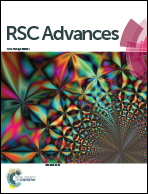Construction of heterostructured TiO2/InVO4/RGO microspheres with dual-channels for photo-generated charge separation†
Abstract
A novel triple-component TiO2/InVO4/RGO photocatalyst with dual channels for photogenerated charge separation has been successfully synthesized for the first time to improve photocatalytic activity under visible light. The synthesis involved loading of RGO particles on the surface of InVO4 microspheres to form RGO/InVO4, and then depositing TiO2 nanocrystals on the surface of InVO4 by hydrolysis of Ti(SO4)2 at low-temperature hydrothermal conditions. The TiO2/InVO4/RGO exhibited superior photocatalytic performance to bare InVO4, TiO2, TiO2/InVO4, RGO/TiO2, and RGO/InVO4 in degradation of Rhodamine B (Rh B) under visible light. It is suggested that the photogenerated electrons in the conduction band (CB) of InVO4 can quickly migrate to RGO, while the electrons also can be transferred to the CB of TiO2. The dual transfer channels at the interfaces of TiO2/InVO4/RGO result in effective charge separation, leading to enhanced photocatalytic activity. The concept of establishing dual channels for charge separation in a triple-component heterostructure provides a promising way to develop photocatalysts with high efficiency.


 Please wait while we load your content...
Please wait while we load your content...